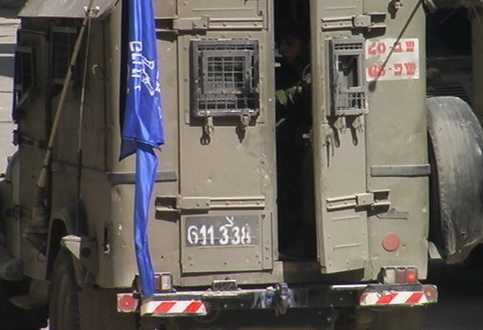Palestinian Center for Human Rights 20 April 2006

This week Israeli forces repeatedly invaded Nablus. (Dylan Bergeson)
Following a bombing in Tel Aviv on 17 April 2006, the Israeli government decided on a series of retaliatory measures against Palestinian civilians, including separating the north and south of the West Bank; denial of access of Palestinian workers to their work places inside Israel; and increasing extra-judicial executions. PCHR reminds the High Contracting Parties to the Fourth Geneva Convention Relative to the Protection of Civilian Persons in Time of War of 1949 that “No protected person may be punished for an offence he or she has not personally committed. Collective penalties and likewise all measures of intimidation or of terrorism are prohibited. Pillage is prohibited. Reprisals against protected persons and their property are prohibited.” (Article 33).
Killing: On Monday evening, 17 April 2006, a Palestinian child, 15-year-old Mamdouh ‘Obaid, was killed and two other were wounded, when IOF fired a number of artillery shells at Sheikh Zayed town, to the east of Beit Lahia. One of the shells hit a playground, where at least 20 children were playing football. On 15 April 2006, ‘Ayada Suleiman ‘Abdullah al-Tarabin, 28, from Rafah, died from a wound he had sustained on 7 April 2006. Al-Tarabin was wounded by shrapnel throughout the body when IOF aircrafts launched missiles at a number of Palestinians in Rafah. The attack left 5 Palestinians, including a child, dead and wounded 6 others.
During the reported period, IOF continued to shell Palestinian areas in the Gaza Strip. They fired artillery shells at houses. A number of houses and civilian facilities were damaged and 10 civilians, including 4 children, were wounded.
During the reported period, 31 Palestinian civilians, including 25 in Nablus, were wounded by IOF gunfire in the West Bank.
Incursions: During the reported period, IOF carried out repeated incursions into Nablus. IOF also conducted 35 military incursions into Palestinian communities in the West Bank. During these incursions, IOF raided houses and arrested 73 Palestinian civilians, including 10 children. In addition, IOF transformed 10 houses into military sites. IOF used undercover units and trained dogs during these incursions. In an attempt to exert pressure on allegedly wanted Palestinians to surrender, IOF arrested 7 of their wives and mothers. Later, 6 of these women were released, while the seventh has remained in custody.
Restrictions on Movement: IOF have continued to impose a comprehensive siege on the OPT, in violation of civil, political, economic, social and cultural rights of Palestinian civilians.
IOF have continued to impose a tightened siege on the Gaza Strip, transforming it into a large prison. IOF have continued to monitor the movement of Palestinian civilians through Rafah International Crossing Point on the Egyptian border. Although IOF have allowed the transportation of food aid from Egypt into the Gaza Strip through Kerem Shalom commercial crossing, southeast of Rafah, the crossing has not yet been officially opened. IOF have also continued to prevent Palestinian workers from the Gaza Strip from reaching their work places in Israel through Beit Hanoun (Erez) crossing. They have continued to prevent hundreds of thousands of Palestinians living in the Gaza Strip from traveling to the West Bank. IOF have closed al-Mentar (Karni) commercial crossing, east of Gaza City. During the reported period, the crossing was reopened for a few hours. As a result, the economic conditions in the Gaza Strip have deteriorated.
IOF have continued to impose a tightened siege on Palestinian communities in the West Bank. IOF positioned at various checkpoints in the West Bank have continued to impose severe restrictions on the movement of Palestinian civilians. Following the bombing that occurred in Tel Aviv on 17 April 2006, IOF decided to separate the north and south of the West Bank. On Tuesday morning, 18 April 2006, IOF closed Za’tara checkpoint, south of Nablus. IOF also reinforced their presence at various checkpoints in the West Bank. During the reported period, IOF positioned at various checkpoints in the West Bank arrested 8 Palestinian civilians, including two children.
Annexation Wall: IOF have continued to construct the Annexation Wall inside the West Bank. During the reported period, IOF closed all outlets of the Wall along the main road between Dahiat al-Bardi checkpoint, north of Jerusalem, and Qalandya crossing, south of Ramallah. According to eyewitnesses, IOF erected a checkpoint on the road in the morning and started to close all outlets. IOF have therefore separated the Dahiat al-Barid area and al-Ram village from the city. Before the closure of these outlets, Palestinian civilians used to travel to the city directly through the Arab Post intersection towards al-Dahia checkpoint, but following the closure, they are forced to pass through Qalandya checkpoint in the north and then must travel back to the south. At least 70,000 Palestinians living in the Dahiat al-Barid area, al-Ram village, the Sameeramis area and Kufor ‘Aqab village, north of Jerusalem, who have Israeli identity cards, are now threatened with separation from Jerusalem and are therefore being deprived of their political, civil, economic, social and cultural rights. IOF also closed iron gates in the Wall in some areas of the West Bank and prevented Palestinian civilians from reaching their agricultural lands.
Illegal Settler Activities: Israeli settlers in breach of international humanitarian law continue to reside in the OPT and have launched a series of attacks against Palestinian civilians and property. During the reported period, Israeli settlers and IOF violently beat a Palestinian civilian and his child in Hebron. In addition, Israeli settlers from “Routam” settlement, in the Wadi al-Maleh area of the northern Jordan Valley, positioned a mobile home surrounded by barbed wire in the area.
To download the full report click here.
Related Links